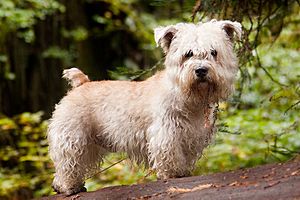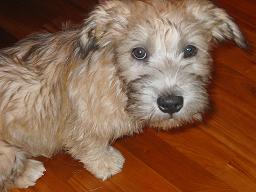Glen of Imaal Terrier facts for kids

An adult wheaten Glen of Imaal Terrier
|
||||||||
| Other names | Irish Glenn of Imaal Terrier, Wicklow Terrier | |||||||
|---|---|---|---|---|---|---|---|---|
| Common nicknames | Glen, Glennie | |||||||
| Origin | Ireland | |||||||
|
||||||||
| Domestic dog (Canis lupus familiaris) | ||||||||
The Glen of Imaal Terrier (Irish: Brocaire Uí Mháil) is a special type of dog from Ireland. It's one of four terrier breeds that come from Ireland. People sometimes call it the Irish Glen of Imaal Terrier or the Wicklow Terrier. Many just call it a "Glen."
This dog breed gets its name from the Glen of Imaal in County Wicklow, Ireland. The Irish Kennel Club first officially recognized the breed in 1934. Later, the American Kennel Club recognized it in 2004.
The story of the Glen of Imaal Terrier began a long time ago. During the time of Queen Elizabeth I, soldiers from other countries came to Ireland. These soldiers brought their own dogs with them. They bred these dogs with local terriers in the Wicklow area. Over time, this mix created the unique Glen of Imaal Terrier.
Glens were originally working dogs on farms. They helped get rid of animals like rats, foxes, badgers, and otters. They were also good at herding animals and were loyal family pets. Unlike many terriers, Glens were bred to work quietly. They would go into animal dens without barking. This is why they are known as some of the quietest terriers today.
Some old Irish stories say that Glen of Imaal Terriers also helped with cooking. They were supposedly used as turnspit dogs to turn meat over fires. However, there isn't much proof for this. Pictures of turnspit dogs from the 1800s don't look much like today's Glens. Still, this story is often shared when people talk about the breed.
The breed almost disappeared a while ago. But in the early 1900s, breeders in Ireland helped bring them back. Today, the Glen of Imaal Terrier is still quite rare. It is one of the least known Irish terrier breeds. The UK's Kennel Club considers it a vulnerable native breed. This means fewer than 300 puppies are registered each year.
Contents
Appearance of a Glen of Imaal Terrier
The Glen of Imaal Terrier is often called a "big dog on short legs." This is because they have a special type of dwarfism. They are heavier than they look in pictures. A typical adult Glen weighs about 36 pounds and stands 14 inches tall. The official breed standard says males should be about 35 pounds and females a little less. They are also longer than they are tall. Some champion Glens can even weigh over 40 pounds. It can take up to four years for a Glen to grow to its full size.
Glens have a large head with ears that can be rose-shaped or half-prick. Their legs are short and bowed. Their back is straight and rises slightly towards the tail. Their shoulders, chest, and hips are strong and muscular. Their front feet turn outwards. Glens are known for their natural, "rough and ready" look. They have old-fashioned features that were common in early terriers.
Glen of Imaal Coat and Grooming
Glens have a special double coat. The outer layer is wiry, and the inner layer is soft. On their head, sides, and legs, they only have the softer coat. This softer coat often has a wavy look. Their fur can be wheaten (a golden-yellow color) or blue. Blue Glens usually have streaks of other colors, called brindling. Sometimes, other colors appear, but they are not as common.
Wheaten Glen puppies often have black fur highlights. They might also have a darker stripe down their back when they are young. But these dark marks usually disappear as they grow up.
Glen of Imaal Terriers do not shed much hair. They need to be brushed or combed every week or two. This keeps their soft coat from getting tangled. It's also common to remove extra "dead" hair from their wiry coat a few times a year. This is called stripping, and it's easy and painless with the right tools.
For dog shows, Glens need a little extra grooming. But they are meant to look natural, not perfectly trimmed. They should look tidy but never clipped or overly styled.
Glen of Imaal Tail Docking
In the past, a Glen's tail was often shortened. This was done so handlers could pull the dog out of badger holes. Tail shortening is still common in the United States. However, some breeders have stopped doing it. In many countries, shortening a dog's tail for shows is now against the rules. For example, in Ireland, it's illegal to show dogs whose tails were shortened after March 6, 2014.
Health of a Glen of Imaal Terrier
There is a special test for a genetic eye problem called progressive retinal atrophy (PRA). This condition can cause blindness in Glens starting around five years old. Since the problem shows up later in life, it used to be hard to prevent. Now, with the test, breeders can make sure puppies won't get this type of PRA. Even if a puppy carries the gene, it won't go blind if one parent was clear. Responsible breeders use this test to keep the breed healthy.
Glens rarely have heart problems. Some Glens might have allergies or itchy skin, especially on their paws. This often happens in wet weather. Glens usually don't have the back problems seen in some other long-backed dog breeds. Hip problems are rare and usually mild. Responsible breeders check their dogs' hips to make sure they are healthy for breeding.
Young Glens are front-heavy and have dwarfism. This makes them more likely to get injuries to their growth plates in their front legs. Owners should try to stop young Glens from jumping off high places like sofas or beds until they are at least one year old. If a Glen starts limping, it's important to see a vet.
After 12 months of age, Glens generally do better on a diet with less protein than other dog breeds.
Temperament and Behavior
Glen of Imaal Terriers can be very active and determined. But they are usually calmer and quieter than most other terriers. They love to play, but they are also happy to relax next to their owner.
Their bark is deep and strong, like a much bigger dog. They are known to be good watchdogs.
The "Glen sit" is a funny posture unique to this breed. The dog sits straight up on its hind legs, holding its whole body vertical.
Like all terriers, Glens can be a bit stubborn. But they learn quickly and respond well to consistent training. They are smart and make friends easily. Glens are usually brave and loyal. They are also great with people, including children. However, some Glens can be aggressive towards other dogs, especially if they feel threatened.
As they grow up, most Glens develop a strong instinct to hunt small animals. They will go after rats and other vermin. So, it's important to introduce them to other small household pets, like cats or rabbits, when they are young. This helps them learn not to mistake them for prey.
Glens often do well in dog sports like Earthdog trials and Barn Hunt. They can also be good at agility courses. Because of their short legs and heavy bodies, they are not usually strong swimmers. But some Glens can work in water. Some have even been trained to herd sheep and cattle.
Relationship to Other Breeds
The exact history of the Glen of Imaal Terrier is not fully known. Some people think it might be related to the Soft-coated Wheaten Terrier, another Irish terrier. Some even believe all Irish terrier breeds came from the Soft-Coated Wheaten. The "low-slung hounds" that helped create the Glen might be related to the PBGV breed. These hounds may also be the source of the Glen's dwarfism.
Even though the Glen looks a bit like Scotland's Dandie Dinmont Terrier, they don't seem to be closely related. DNA studies show that the Glen of Imaal Terrier is more closely related to mastiff-type dogs than to other terriers. This is interesting because their looks and jobs are more like terriers.
See also
 In Spanish: Glen of Imaal Terrier para niños
In Spanish: Glen of Imaal Terrier para niños




